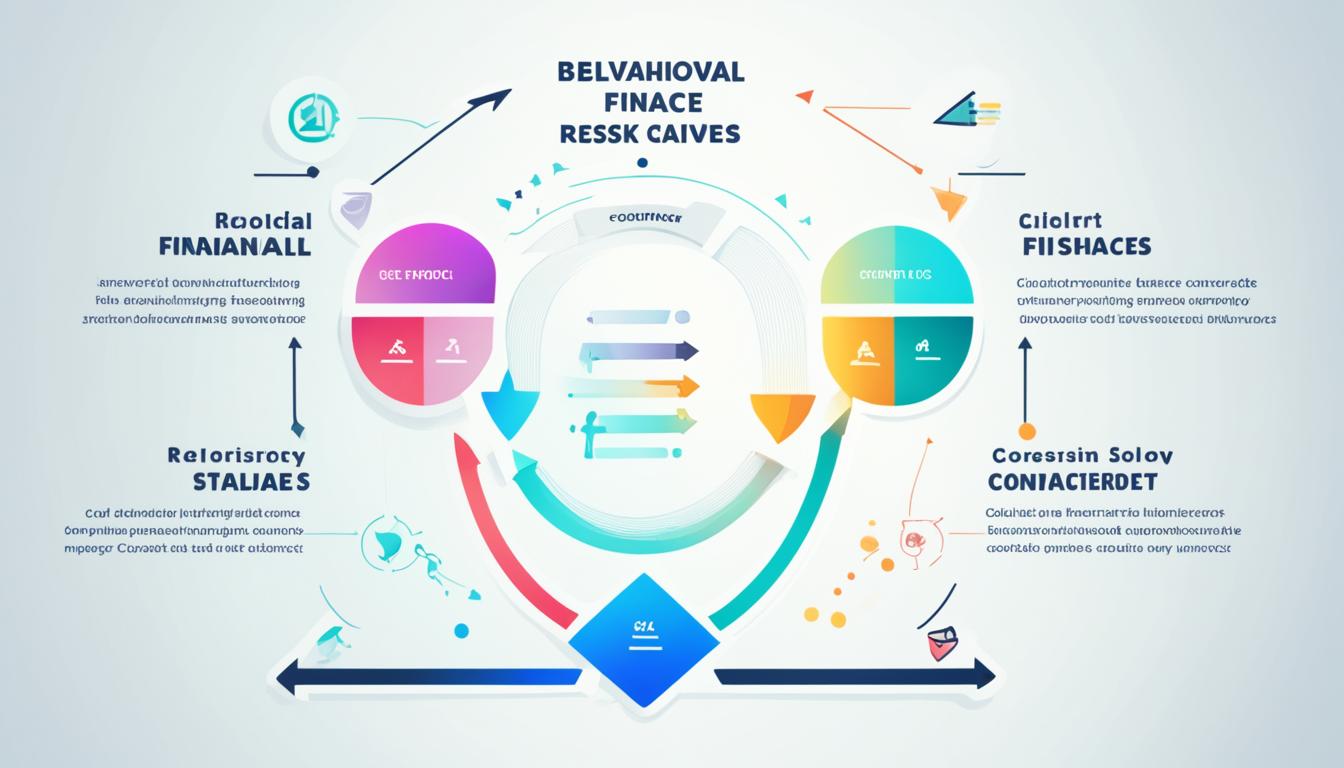Behavioral finance mixes psychology with economics to explore why people act irrationally with their money. Unlike traditional theories, it doesn’t assume people always make logical choices. It looks at how our minds and emotions can lead to financial mistakes. For those working with money, knowing about types of behavioral finance is key to making sense of the market.
Real-life examples show us how our choices differ from what economic models predict. Think of things like being too sure of ourselves, avoiding losses at all costs, and following the crowd. These issues can mess with the market and our investments. But understanding these cognitive biases in finance can help us make smarter choices.
Key Takeaways
- Behavioral finance combines psychology and economics to study financial decision-making.
- It challenges the traditional view that people are rational market actors.
- Real-world examples include overconfidence, loss aversion, and herd behavior.
- Understanding these biases can improve investment strategies.
- Knowledge of behavioral finance is essential for navigating market dynamics.
Understanding Behavioral Finance
Behavioral finance combines psychology and economics. It helps us understand why people make certain financial decisions. By looking at the psychology behind these choices, we can see why investors sometimes make mistakes.
Definition and Scope
Behavioral finance focuses on the psychological side of money matters. It doesn’t assume investors always act rationally. It looks at the shortcuts and emotional influences that often lead to bad choices.
This field explores beyond individual decisions. It also looks at broader market trends. Understanding the psychology of investing has deepened our knowledge of market behaviors.
The Importance of Behavioral Finance in Modern Markets
Nowadays, behavioral finance is more important than ever. With markets getting more complex, it’s crucial to understand why people make the choices they do. This understanding helps create strategies that counter common financial biases.
Experts like Richard Thaler and Daniel Kahneman have greatly developed this field. They’ve shown how psychological traps can affect various financial areas. Their work helps modern markets develop tools to avoid these pitfalls.
| Key Concepts | Examples | Impact |
|---|---|---|
| Emotional Investing Psychology | Fear and Overconfidence | Market Volatility |
| Psychological Aspects of Investment Decisions | Behavioral Biases | Suboptimal Investment Choices |
| Biases and Heuristics in Finance | Anchoring, Herding | Price Distortions |
Types of Behavioral Finance
In behavioral finance, we study why people often make choices that aren’t fully logical. We look at how our brains work, our emotions, and other factors that affect how we invest.
Cognitive Biases in Finance
People sometimes think and decide in ways that aren’t normal or smart when it comes to money. This affects how they invest. A few common examples are:
- Overconfidence: Some investors think they know more than others and can predict the market perfectly. This makes them take bigger risks.
- Anchoring: Investors often stick too much to the first thing they learn when deciding, even if it doesn’t matter.
- Herding: Some just copy what everyone else is doing, instead of thinking for themselves.
These behaviors can cause major problems in the financial world, like creating market bubbles or sudden drops in prices.
Emotional Investing Psychology
Our feelings play a big part in how we invest. Sometimes, decisions are based more on emotion than actual facts. The main emotions that impact us include:
- Fear: Worry about losing money can push people to sell their investments early, often losing money.
- Greed: Wanting to make a lot of money fast can lead to taking very big risks, hoping to follow popular investment trends.
- Regret: Past mistakes can lead to too cautious or too risky investment decisions in the future.
Psychological Factors in Investment Behavior
Human behaviors and social influences can sometimes be more powerful than clear thinking when making investment decisions:
- Social Proof: We often copy what others do, especially when we feel unsure, believing that they know better.
- Loss Aversion: The fear of losing money is stronger than the desire to make it, causing people to avoid beneficial decisions.
- Availability Heuristic: People sometimes choose what to invest in based on what information is most easily reached, not necessarily what’s best.
Understanding these psychological aspects is key to making better investment choices. It helps us avoid the common pitfalls and biases in the financial world.
| Bias | Definition | Impact on Investment |
|---|---|---|
| Overconfidence | Excessive faith in one’s own knowledge | Riskier investments, potential losses |
| Anchoring | Overreliance on initial information | Incorrect valuation, poor decision making |
| Herding | Following the crowd | Market bubbles, irrational investments |
| Fear | Aversion to losses | Premature selling, undermined growth |
| Greed | Desire for quick gain | Excessive risk-taking, potential for significant losses |
Common Behavioral Finance Biases
Behavioral finance looks at how people’s emotions lead to bad money choices. By knowing about these biases in finance, we can make smarter investing picks. Here, we’ll talk about big biases and rules in money that can mess up how well we do with investments.
Confirmation bias is a big one. It means people like news that agrees with what they already think. They ignore anything that doesn’t fit. This can make them too sure about bad investing plans.
Loss aversion is another big deal. It explains why people would rather not lose money, even if it means they might not make as much. This idea is key in money behavior. It’s why some might sell stocks too soon if they’re winning and keep the ones that are losing too long.
Hindsight bias is also common. It makes people think they knew something was going to happen after the fact. But really, they didn’t know at the time. This can make them judge their investing moves wrongly.
Dealing with these biases needs work. Investors can try things like having many different types of stocks in their portfolio. They can also make rules for when to buy and sell. Talking to financial advisors can bring in fresh ideas, too.
Here’s a table that shows some biases and what they can do to investing:
| Bias | Description | Impact on Investment Choices |
|---|---|---|
| Confirmation Bias | Favoring information that confirms existing beliefs | Overconfidence in flawed strategies |
| Loss Aversion | Preference to avoid losses rather than acquiring gains | Premature selling of winning stocks |
| Hindsight Bias | Belief that past events were predictable | Erroneous evaluation of past decisions |
Get to know these biases and heuristics in finance to steer clear of bad money moves. Even the most researched plans can fail because of these biases. So, staying alert against their pull is key for any investor.
The Impact of Behavioral Finance on Investor Decision Making
Behavioral finance has changed how investors see their decisions in the money world. It looks at the mindset behind investing to show how emotions and biases can affect choices. Overconfidence and fearing losses can make investors make bad decisions. This can hurt their performance in the market.
Investor Decision Making Factors
Many mind tricks can affect how investors decide. People might only see what confirms their ideas, or they might feel like they knew what would happen after it happened. These are called biases. Then, there’s the way emotions like fear and greed can change how the market moves. Recognizing these problems can help investors make stronger choices.
By sticking to a plan and spreading investments, investors can deal with these issues better. They also use methods that make them invest without letting emotions rule. As the finance world changes, knowing about these mind games is important. Learning from experts can also help investors adapt to new trends, keeping their money safe and growing.
FAQ
What is Behavioral Finance?
Behavioral finance mixes psychology with economics. It looks at why people make choices that don’t seem smart, money-wise. It’s different from the old idea that everyone acts rationally in the market. Instead, it digs into how our minds and feelings can push us to make bad decisions.
What are the key concepts in Behavioral Finance?
In behavioral finance, we deal with things like thinking we know more than we do, leaning too heavy on first impressions, and following others’ actions. These often cause us to not think straight when it comes to our money, like making bad investments.
How does Behavioral Finance differ from traditional finance theories?
Traditional theories believe we act with logic and that the market runs smooth. Behavioral finance, though, understands that our thinking and emotions can mess with our financial choices. This can shake up the market’s smooth operation.
Why is Behavioral Finance important in modern markets?
Today, behavioral finance is key. It helps us understand the weird stuff we see in the market that old theories can’t explain. Learning about our psychological quirks around money can improve how we plan and predict in finance.
Can you provide examples of Cognitive Biases in Finance?
Two common mental traps in finance are thinking we’re smarter than we are (overconfidence) and sticking too hard to the first info we get (anchoring). These biases often make us choose investments that aren’t the best.
What is Emotional Investing Psychology?
Emotional investing psychology is when our feelings, like fear and the desire for more money, guide our investment actions. For example, being too scared can make us sell stocks too early. Being too greedy can lead to risky decisions or holding onto assets longer than we should.
What are Psychological Factors that influence Investment Behavior?
Two big psychological influences in finance are social proof (copying others’ financial moves) and herd mentality (following what everyone else is doing). These can cause big market problems, like bubbles and sudden drops.
What are some Common Behavioral Finance Biases?
Seeing only what agrees with us (confirmation bias), fearing losses more than we enjoy gains (loss aversion), and thinking we knew how things would turn out after they happened (hindsight bias) are three big biases. They can lead us to make choices that are not in our best interest when it comes to money.
How can investors mitigate the impact of Behavioral Finance biases?
To fight these biases, knowing they’re there is half the battle. It’s also good to diversify, have clear money goals, and keep an eye on and adjust your investments as needed. Getting advice from people who look at the facts rather than follow feelings can also be a big help.
How does Behavioral Finance impact Portfolio Construction and Risk Assessment?
Behavioral finance makes us look at how our thinking and feelings can lead us to take too many or too few risks. Recognizing these mental traps helps us make smarter, more even-handed investment decisions. In the end, this can lead to better financial situations.






